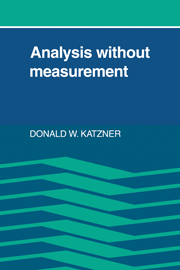2 - Notes on measurement
Published online by Cambridge University Press: 04 August 2010
Summary
The purpose of this chapter is to outline briefly some of the important ideas relating to various forms of measurement. A complete survey is not intended. Only those notions relevant to determining the sorts of things that are required to have measurement (and hence must be absent without it) are discussed. The chapter begins with the most primitive form of measurement, namely, verbal classification by type or property. It then proceeds to the more precise and systematic characterization of properties on ordinal, interval (cardinal), and ratio scales. Problems arising from treating ordinal data as if they were interval data are also considered.
Types
Our world is so complex and diverse that raw, untempered observation of it produces only massive and hopeless confusion. To make any sense of the chaos at all requires abstracting from differences (based on properties or attributes) between things or objects that are seen. This furnishes a basis for making comparisons and hence for determining when two things are distinct or identical. Collections of identical things define groups. The process is one of categorization or delineation of type. Once categories are established, identification of a fresh object, that is, its assignment to one of the groups, becomes possible. Classification therefore emerges at the very core of human understanding. Implicitly, if not explicitly, it is a prerequisite to the modeling of any real phenomenon.
- Type
- Chapter
- Information
- Analysis Without Measurement , pp. 33 - 50Publisher: Cambridge University PressPrint publication year: 1983



